Product Showcase
What caught our interest Pg. 24
Creative Eye Style and function Pg. 20
Basements
Humidity-busting tactics Pg. 14

Product Showcase
What caught our interest Pg. 24
Creative Eye Style and function Pg. 20
Basements
Humidity-busting tactics Pg. 14

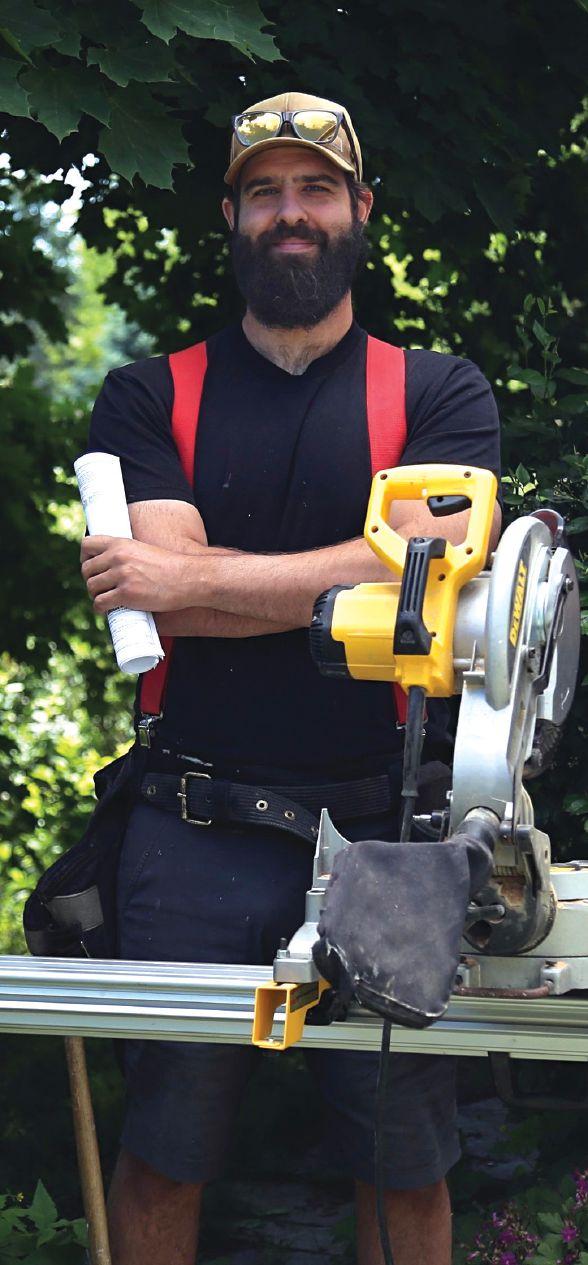
One-stop solutions from Otis Interiors Page 16




Whether you like to read, listen or watch, Canadian Contractor has you covered.



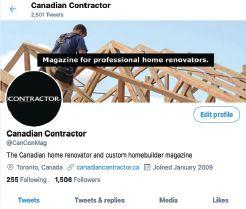
Your weekly roundup of the key pandemic news from Canada’s construction industry. Stay informed of the latest developments in lockdown rules, government assistance and inspiring stories of coping and helping from across the country.
Canadian Contractor editor Patrick Flannery talks to top experts about the big issues facing Canada’s renovation and custom home contractors on our monthly podcast. Visit canadiancontractor.ca for episodes, or subscribe on your favourite podcasting service.
Canadian Contractor’s video library holds hundreds of helpful tips, insightful interviews and revealing profiles with prominent professionals. Tune in today!
Follow @CanConMag or look us up on Facebook to add Canadian Contractor to your daily diet of online interaction.
ISSN 1498-8941 (Print)
ISSN 1929-6495 (Online)

Editor Patrick Flannery PFlannery@annexbusinessmedia.com
Associate Editor Sukanya Ray Ghosh SRayGhosh@annexbusinessmedia.com
National Account Manager Amanda McCracken 226-931-5095 AMcCracken@annexbusinessmedia.com
Media Designer Mark Ryan
Publisher Danielle Labrie 226-931-0375 DLabrie@annexbusinessmedia.com
Account Coordinator Barb Vowles bvowles@annexbusinessmedia.com
Circulation Manager Beata Olechnowicz bolechnowicz@annexbusinessmedia.com Tel: 416-510-5182
Martin McAnulty, Vice President Sales mmcanulty@annexbusinessmedia.com
Scott Jamieson, COO sjamieson@annexbusinessmedia.com
Circulation email:bolechnowicz@annexbusinessmedia.com Tel: 416-510-5187
Fax: 416-510-6875 or 416-442-2191
Mail:
Toronto, ON M2H 3R1
There’s a new team running the show here at Canadian Contractor. You met me, Danielle Labrie and Amanda McCracken in last issue’s Site Notes. Since then, we’ve added Sukanya Ray Ghosh as associate editor.
We have a lot to do to get to know you and this industry, and to gain the trust we know you had in Rob Koci and Steve Payne, the founders of this magazine and its drivers for the last 20 years. That won’t happen overnight, but we’re committing right here to putting in our best effort to maintain this publication’s status as Canada’s voice for renovation and custom homebuilding contractors.
How are we going to do that? Mostly, by continuing to do what Steve and Rob did. We’ll bring you the stories of leaders in our field; highlight the incredible work of contractors across the country; address the issues you’re talking about around your offices and jobsites; share expert advice and information from professionals like Steve Maxwell, Paul Duffy and Steve Ryan; and keep you connected to the suppliers that can help your business. Of special interest is keeping the national conversation between contractors going through our online and print Voices sections. This is a group with lots to say and not afraid to say it. Wonderful!
Where we hope to add to Steve and Rob’s legacy is by bringing in voices and expertise from our sister publications in adjacent niche markets. You see, for the last 10 years, Danielle Labrie and I have worked together on Glass Canada, a magazine for commercial glazing contractors, and Fenestration Review, a magazine for window and door manufacturers and dealers. We also run Canadian Rental Service, a trade publication for equipment rental stores. With this magazine and the three others, our team has formed what we are calling a light construction group within our publisher, Annex Business Media. The synergies are fairly obvious. We’re looking forward to bringing the expertise and perspectives from our friends in those sectors here to Canadian Contractor, and to sharing your world with them.
I’ll close with some words on how I approach this business of B2B communications. First, I am not the expert – you are. You know more about how to run your businesses and make beautiful homes than I ever will. No on in these pages will talk down to you or try to tell you what you should do. Where advice is presented, it’s going to come from qualified experts who will present it as ideas to be considered, not lecturing or moralizing. Second, we observe a bright line here between advertising and editorial content. When you are looking at something that someone paid to put in this magazine, you will know it. When you are looking at articles, news, columns and other content appearing under the editorial banner of Canadian Contractor, you can rest assured that no money changed hands to place it and that the message is there for no other reason than because I thought you should read it. Finally, we are certainly not perfect and will make many mistakes in the early days with this fine title. We’re going to depend on your feedback and corrections to get things right. cc

” We’re committing to putting in our best effort to maintain this publication’s status as Canada’s voice for renovation and custom homebuilding contractors.
By Patrick Flannery Editor ”
Our May 25 COVID News directed readers to a lobby group pushing the feds to deliver post-pandemic stimulus in the form of incentives for energy-efficient renovations. Sounds like a good business driver, right? Well, our friend Casey Edge at the Victoria Residential Builders Association suggests pumping the brakes…
You might first want to complete due diligence on the unintended consequences of increasing energy efficiency which is still under review by the Canadian Commission on Building and Fire Codes. B.C. implemented its Energy Step Code before this work had been accomplished. A number of concerns include overheating from solar gain and soil gas ingress (radon). And people wonder how leaky condo happened…
Casey Edge
This led to a point-counterpoint between Edge and Ben Polley of Evolve Builders Group…
Goodness. Casey, it seems that you see red in every possible green initiative. Agreed, constructon performed without regard for sound (building) science might at best, not deliver the desired effect and, at worst, do harm. I imagine that you and I equally could point to such examples, though I will hasten to point out that these are by no means restricted to incidents where energy efficiency gains were sought. The Building Code (NBC or its provincial equivalents) is however only the minimum allowable standard that builders and renovators must follow. Almost by definition, it (and the commission) is not the likely or suitable vehicle through which to promote and incentivize significant improvements in energy efficiency or better still, reductions in both operating energy (carbon) and embodied carbon. With the notable exception of Vancouver and B.C., where the codes are actually beginning to step up to meet our climate needs while providing a clear and shared responsibility for all builders to do so, waiting on the heavily lobbied, politically sensitive, (small-c) conservative commission to address the lowest-cost-of-ownership with highly efficient, environmentally sustainable methods of construction will just slow the potential for real advancement.
Ben Polley
I see orange (caution) not red, in every proposed code change. That’s my responsibility to consumers. History has shown this to be the right approach. You say, “Agreed, constructon performed without regard for sound (building) science might at best, not deliver the desired effect and at worst, do harm” (my emphasis). I am not willing to accept harm (for example, more lung cancer deaths caused by very energy-efficient homes drawing in radon as shown by studies). The CCBFC report says, “The work on unintended consequences is of the utmost importance before the energy efficiency requirements for houses (NECB and Section 9.36)
can be finalized for the 2020 code.” Call that conservative if you like, but a code standard should be conservative and avoid harm. That’s the foundation of a code standard – proven practice. That in no way means I am opposed to energy efficiency. It means I support due diligence on behalf of consumer protection, which frankly many energy efficiency advocates, including the B.C. government, would rather circumvent. It seems due diligence is an inconvenience, as it was with leaky condo, now long forgotten by regulators, bureaucrats and elected officials vying for green leadership. The B.C. Step Code enables municipalities to bypass steps, which is why it is a “leap code” and not a step code. I could go into issues like Vancouver municipalities leaping into high steps without radon mitigation while homes have tested for elevated levels of radon. But these points just seem to irritate regulators, bureaucrats, elected officials and a handful of energy efficiency advocates.
Casey Edge
It’s human nature…people won’t wear PPE if it’s uncomfortable or makes it hard to work. Marten explains… This is an interesting one for sure. I started back this week. I work mostly in the commercial sector installing doors, hardware and other miscellaneous stuff, so mostly finishing end of the game. The site I was on had signs all over the place about being distant. Hand washing stations were set up. They had gloves for anyone that wants them as well. You had to wear a mask as well. This is in a hospital so it was the same masks the hospital staff wears. I took a mask for the first day but also had a handmade one. The one given to me was incredibly uncomfortable and hurt my ears. It also fogged up my glasses. The homemade one was a bit more comfortable but not much. Still fogged my glasses up. It got better as the week went along as my wife and I worked together to make it better. I have seen some guys wearing the masks, some had them around their chins. The site supervisor walked by and everyone jumped to put them on. He left and they came off. Others were good and kept theirs on. No one wore the gloves as they were too small for most guys. Hard to wear them anyway when what you use would tear them apart right away. Not sure if anyone used the hand washing station. Seems like some guys take this seriously and others not so much. I think people would wear the PPE if it was comfortable but when it hurts to wear it, that is frustrating.
– Marten Burghgraef
Be alert of the numerous phishing email scams and ransomware that could target anyone and everyone out there, warns Brendan Charters of North-York based Eurodale Developments. It could set your business back for some time.
Just a heads up to contractor nation: there are a ton of phishing email scams out there targeting contractors of late. We got hit last week – our servers overtaken by ransomware. Fortunately, we had a backup that was only two weeks old, but wanted to warn our colleagues as it is costly and debilitating and not what any of us need right now. Be sure you have a regular backup (cloud or physical hard drive) and check to make sure it’s working. We had both and only one functioned as designed. We suspect it came from a link a lot of people received for a custom home quote from lilianchang37@yahoo.com as we never received a reply and are now receiving spam for industrial project leads from the same sender, with just a link. Shortly after that email our servers were fully encrypted. We have never felt more our old age than now…we thought this stuff only happened to octogenarians!
Brendan Charters
In a Voices item with a lot of criticism of celebrity contractor Mike Holmes, reader Debbie appreciates his approach that draws from experience instead of theory. Schooling is great but you learn the teachers’ ways a lot of the time. Some teachers are not the greatest with

The next generation of outdoor faucets.
information. As for textbooks, it depends on who writes them as well. Mike Holmes has written books. Would it be okay if he were to write the textbooks for the schools? Life lessons are better learning tools than some CEO sitting in an expensive office with letters behind his name from schools but cannot build an outhouse. I am a prime example of someone with education but not a lot of experiences. Mike Holmes goes over and above; he is someone I would rather have than those that are building just in code these days. At least Mike will have built century homes one day. These others will be lucky if their builds last 10 years. Mike has earned respect. There is nothing wrong with perfection.
Debbie
The Voices section in the magazine selects readers’ comments that are sent through emails or posted online. To be featured here, please share your opinions about the different subjects, topics and ideas discussed on canadiancontractor.ca.

Available from:
www.brontecollection.ca
Renovation Contractor magazine has been acquired by Annex Business Media, publisher of Canadian Contractor.
Purchased from the Homes Publishing Group, the brand has been added to Annex’s light construction media group. The group includes Glass Canada, Canadian Rental Service, and Fenestration Review, as well as Canadian Contractor. Renovation Contractor will be integrated into the Canadian Contractor brand. The nine-year-old B2B publication serves the Canadian home renovation contractor market, including custom homebuilders, carpenters, roofers, plumbers, drywallers, contractors and HVAC professionals, and brings additional subscribers and content archives to Canadian Contractor and its partner media brands.
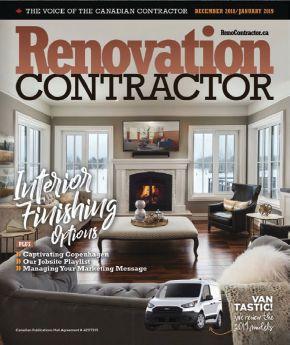
like to thank Joel for his tremendous contributions to Home Hardware over a long and impressive career.”
“It has been an honour and a privilege to serve our dealerowners over my career at Home Hardware,” said Marks. “The Home team has been like family and it has been an honour to contribute to the tremendous growth of such a special company.”
As a result of the change, Marianne Thompson has been appointed as the company’s senior vice-president of merchandise, effective June 15, 2020. In Thompson’s expanded role, she will oversee the entire merchandise team as Home Hardware continues to strategically review and advance its position towards an integrated retailer.
“Our number-one priority is providing our dealers with the best program for independents in the industry,” noted Macnab. “Marianne has over 30 years of experience in the home improvement industry. Her leadership and strategic acumen have been an excellent addition to our leadership team, significantly raising our merchandise and LBM expertise.”
“Home Hardware has significant opportunity for growth in both the LBM and hardlines categories,” said Thompson. “I will continue to work closely with Kevin, the leadership team and Home Hardware’s dealer-owners to continue to develop the strategic growth plans to support being Canada’s most trusted and preferred home improvement retail brand.”
“I want to welcome Renovation Contractor’s readers and advertisers. We promise to do our best to maintain that magazine’s high standards,” said Patrick Flannery, Canadian Contractor editor. “I invite all of you to contact me with any feedback or suggestions.”
“Renovation Contractor is a great expansion to our already powerful Canadian Contractor brand,” said publisher Danielle Labrie. “Integrated into our light construction group, we are building a compelling communications channel reaching every corner of the market.” cc
Home Hardware has announced the retirement of Joel Marks, vice-president of merchandise hardlines. Marks’ leadership and support at Home Hardware over the past 21 years has helped the retailer remain a significant player in the home improvement industry.

“Joel has played a key role on our leadership team since his appointment to vice president in 2015, bringing almost 39 years of experience in home improvement retailing,” said Kevin Macnab, president and CEO of the company. “I would
The process to identify a new vice-president of merchandise hardlines is underway. Marks has been working with Thompson to ensure that the company is well-positioned for a seamless transition. Marks officially retired on June 12. cc
Wolseley Canada is aligning its plumbing and HVAC, AMRE supply and industrial businesses by shifting its organizational structure from three operating regions to two. As such, the organization has announced the following promotions:
• Sébastien Laforge has been promoted to vice-president for eastern Canada. He will oversee the eastern plumbing and HVAC business, including Atlantic Canada, Quebec and Ontario, and the day-to-day operations of the industrial business in the region.
• Chris Choquette has been promoted to vice-president for western Canada. He will oversee the western plumbing and HVAC business, AMRE and the day-to-day operations of the industrial business in the region.
Choquette will be based in Burnaby, B.C., and Laforge will be based in Laval, Que.
“The integration of our businesses positions us for success by allowing us to leverage the considerable strengths of our organization in a more coordinated way than ever before,”
says Kevin Fancey, president of Wolseley Canada. “I’m confident that under Chris and Sébastien’s leadership, we will strengthen our ability to deliver exceptional value to our customers.”
Choquette and Laforge are members of Wolseley Canada’s executive management team and report directly to Fancey. Previously general manager of western Canada plumbing and HVAC business, Choquette brings a wealth of experience to his new role. Prior to joining Wolseley as senior director of B.C. plumbing and HVAC business in 2019, he was the general manager of business solutions at Ledcor Technical Services and held leadership positions at Acklands-Grainger. Laforge has made significant contributions to Wolseley Canada since joining the organization as director of finance in 2007, where he held a position in a financial role for the eastern region of the business. In his most recent position as general manager of Quebec plumbing and HVAC, he led and oversaw significant change and growth in the region. cc
Government officials in British Columbia are asking nonprofit and Indigenous housing societies, First Nations, housing co-operatives and municipalities to submit ideas for new affordable housing projects. The projects will be considered for the second intake of the Building BC: Community Housing Fund. The fund was announced in 2018 as part of B.C.’s 10-year, $7 billion plan. The fund has set aside $1.9 billion to build more than 14,000 mixedincome rental homes for middle- and low-income families and individuals. During the past two years, more than 5,200 homes have been completed, are under construction or in development through this program in more than 40 communities. The RFP is being done through BC Housing and is expected to result in 3,000 new affordable homes.
“During these extraordinary times, it is clearer than ever that safe, secure and affordable housing is critical for all British Columbians,” said Selina Robinson, minister of municipal affairs and housing, in a press release. “These new projects will deliver urgently needed rental homes for people, while also creating good jobs and supporting B.C.’s economic recovery.”
The fund prioritizes housing projects where 20 percent of the units are for households with very low incomes (including those on income assistance), 50 percent of the units are for households with incomes up to $64,000 and 30 percent of the units are for households with incomes up to approximately $74,000. Proposals will start being accepted May 27 and the RFP will remain open until mid-January 2021. Officials encouraged organizations to apply early as an initial round of projects will be approved in fall 2020.
Funding is available to groups that applied for the first round of funding though the Community Housing Fund and to those who have applied for other Building BC funds. All Building BC funding programs are open to First Nations. cc

Pomerleau has announced its participation in the Lunch Box Challenge, accepting the invitation from Scott Construction Group – the instigator of the initiative. The Lunch Box Challenge aims to recognize the commitment of construction workers by offering them boxed lunches from a restaurant located near the site, thereby supporting a local business. The 70 workers at Purolator’s new national Super Hub site were excited to be treated with lunch boxes prepared by the San Francisco Café on June 9. The individual meals, wrapped in recyclable materials, were enjoyed according to the rules of physical distancing in force in order to ensure a safe environment for all. The team, in turn, nominated the PCL Construction team at Toronto Pearson International Airport to join the challenge.
“Faithful to our family culture and our engagement to our communities, we are very proud to embark on the adventure of the Lunch Box Challenge which accomplishes two very important goals: highlighting the exceptional work of our colleagues while supporting local restaurateurs during these difficult times,” explained Éric Gaulin, executive vicepresident of the Canadian building operations division at Pomerleau. “I would like to salute the leadership of Scott Construction, which has created an inspiring movement in our industry. And for Pomerleau, this is just the beginning. We are committed to making the challenge a coast-to-coast initiative by offering meals in all the provinces where we have active worksites.”
On June 11, the Commission scolaire des-Portages-deL’Outaouais High School 041 project, in Gatineau, Que., became the next Pomerleau site. It was the first in Quebec to join the movement. The Lunch Box Challenge is expected to gain further traction in the industry as Pomerleau continues to challenge others to partake. Pomerleau’s involvement in the Lunch Box Challenge reinforces the spirit
of the “Love is an essential service” initiative launched in early June to specifically help organizations working in health care, research and health, as well as in food aid to vulnerable populations affected by the COVID-19 pandemic. An additional $600,000 enhanced Pomerleau’s annual philanthropic commitment to support the exceptional efforts of 14 community organizations across the country. cc
On May 7, 2020, the board of directors of the Surety Association of Canada gave its approval to a new specialty bond form designed for use with Integrated Project Delivery projects. The new bond template had been under development for more than a year and is designed to be used in conjunction with the standard CCDC-30 Integrated Project Delivery Contract. The IPD model seeks to create a team approach where all parties enter into a single contract, and where the decision making, the risks and the profits are shared. Proponents of the model suggest that this approach should minimize, if not eliminate, the adversarial dynamic that can develop when each party pursues its own interests and hopefully incentivize more cooperative and collaborative relationships. Like any non-traditional project delivery approach, IPD presents a new set of challenges to the construction industry as it works to create a sustainable and workable model that puts the theory into practice. One such challenge surrounds risk mitigation and, in particular, the risk of contractor (or other party) failure. In discussing the need for protection against that risk of contractor failure, SAC has found that IPD proponents will often dismiss these concerns. They point to the all-hands-on-deck approach of the IPD arrangement and suggest that this coordinated focus on the common interest diminishes any such risk to the point of being insignificant. SAC president Steve Ness suggests that this simply is not the case.
“Bonding companies have learned the hard way that the risk of contractor default doesn’t always originate within the four walls of the project itself. Many and perhaps most of the issues that give rise to project contractor failure are business- or finance-related and may have little or nothing to do with that contractor’s ability to successfully perform the work on any particular project,” he said.
Ness pointed out that replacing a failed contractor midway through a construction project can be an expensive proposition, begging the question, what will happen should a major participant in an IDP contract become insolvent? In response to this challenge, SAC has developed a template performance bond that responds to the unique structure and working dynamics of the IPD project arrangement. In creating this new product, SAC undertook a comprehensive review of the complex inter-relationships between parties to IPD
contracts. From there, the drafting team identified the points of vulnerability to that risk of failure of the project contractor and/or one of the other construction participants to the IPD team. While the new bond template is intended for use with the CCDC-30 standard, it also seeks to be flexible enough for use with modified versions of this document and for other variations on the IPD theme. Ness re-emphasized that no contractual arrangement, no matter how well-intentioned or collaborative, is risk-free.
“The risk of a major contractor insolvency or failure, if not adequately managed, can have catastrophic consequences to the project and all of its participants. A surety instrument specifically created for use on IPD projects will go a long way toward mitigating that risk.”
A specimen copy of the new SAC IPD bond along with a user’s guide that explains its features can be reviewed and downloaded from the SAC website. cc
The total value of building permits issued by Canadian municipalities plummeted 17.1 percent to six billion dollars in April. The decrease in April was the largest decline since a similar drop in October 2008 during the financial crisis. When combined with the March decline, the value of building permits has fallen by 28.1 percent from February levels. Declines were reported in eight provinces, with the largest in Quebec (minus 34.1 percent) and Ontario (down 20 percent). Although most municipalities were still issuing permits in April, Quebec’s decision to shut down nonessential construction activity due to the pandemic led to it posting its largest month-over-month percentage decline on record. The total value of residential permits was down in nine provinces in April, falling 14.2 percent to $3.9 billion nationally. Using comparable data available back to 2002, permits issued for single-family dwellings fell 35.9 percent to $1.4 billion, a record month-over-month decline and almost double the next largest decrease. Prince Edward Island (off 84.3 percent), Newfoundland and Labrador (down 52.5 percent), Ontario (minus 50.8 percent), Manitoba (37.1 percent decline) and Quebec (down 29.4 percent) all recorded their largest month-over-month percentage declines in the current series. Multi-family dwellings was the only component to show an increase at the national level in April, up 4.8 percent to $2.6 billion. Increased building intentions in Vancouver, Toronto and Ottawa led to gains in British Columbia (up 66.8 percent) and Ontario (13.9 percent better), which more than offset declines in six provinces. The gains in British Columbia returned the value of multi-family permits to more normal levels, following large drops in the previous two months. The decreases in February and March were the result of a large number of permits being pulled forward into January as builders looked to avoid a scheduled fee hike in Metro Vancouver. cc
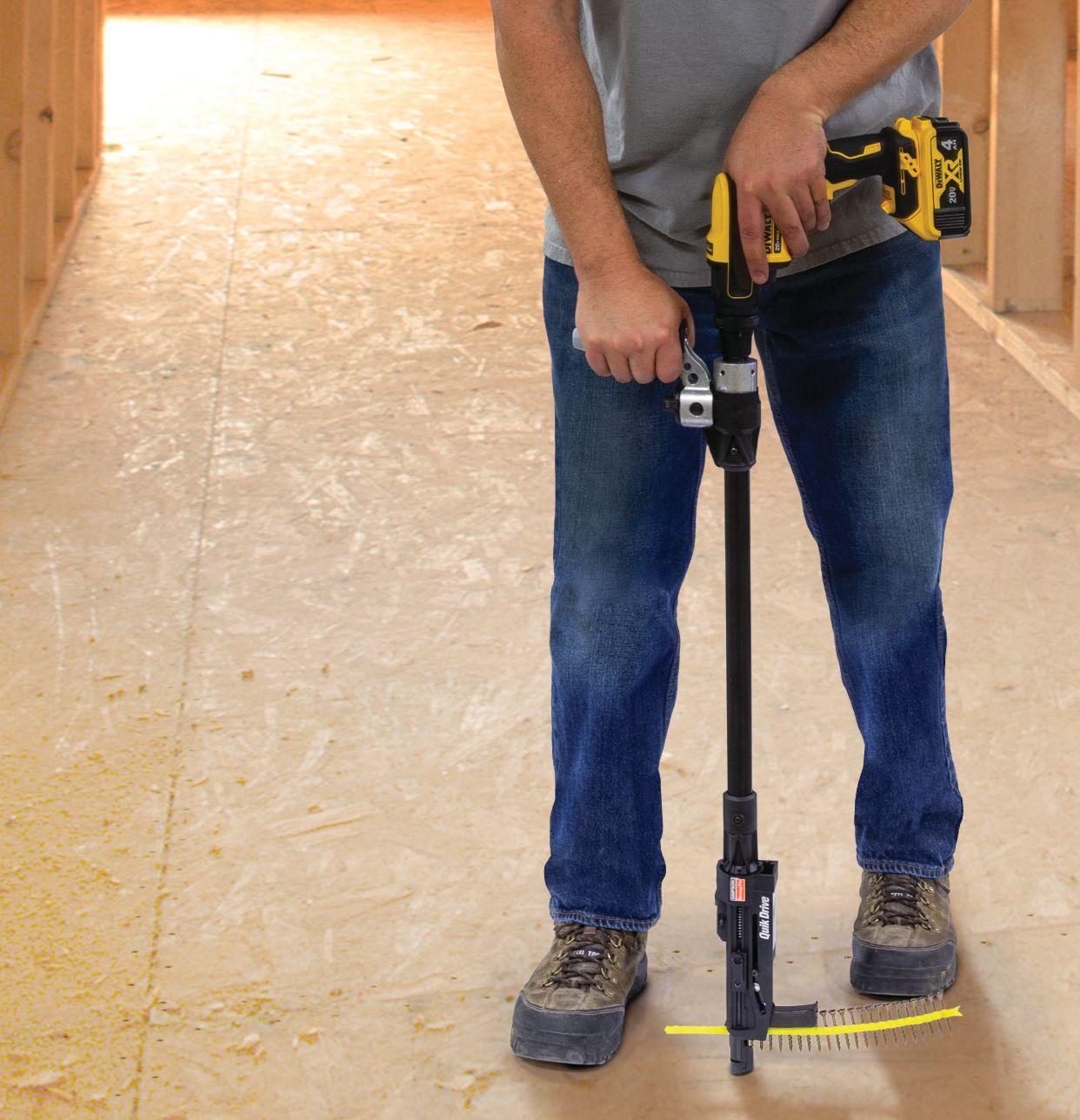

Drive more screws, faster and easier than ever — with the Quik Drive® cordless auto-feed screw driving system from Simpson Strong-Tie. Using our advanced Strong-Drive ® WSV Subfloor screws specially designed to reduce driving torque up to 25%, your batteries will last longer, and you’ll install more fasteners per charge. A powerful DeWalt® motor and lightweight extension make repetitive installation simple and ergonomic. And without the hassle of a cord, you’ll get the job done safely and quickly.
Make your next subfloor job more efficient. Call (800) 999-5099 or visit go.strongtie.com/quikdrivecordless today.
Four business tactics for enduring industry ebbs in the wake of the coronavirus.
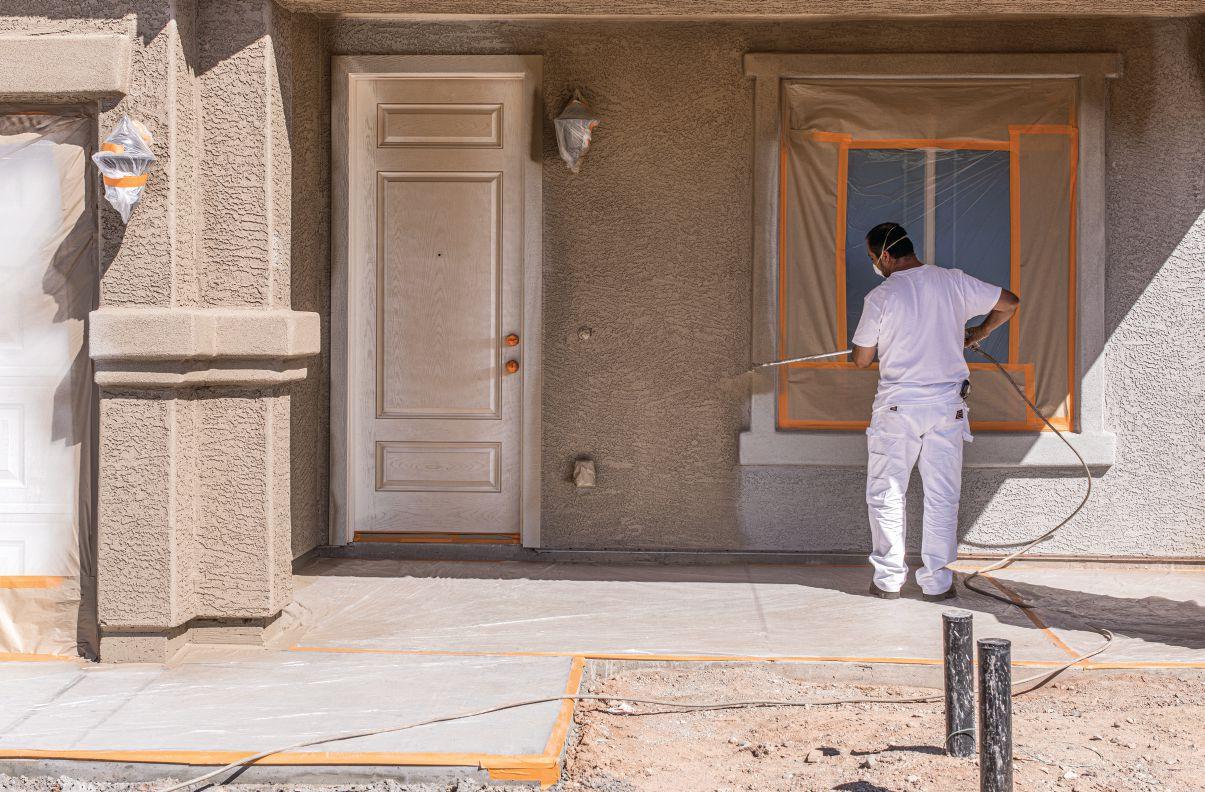
By Scott Robins
Likemost trades, the painting industry feels a significant impact from the fluctuations in national and regional economies. Most painting operations across the country are facing the economic ramifications of the COVID-19 pandemic, along with an uncertain future.
You obviously can’t control the factors that influence the economic ups and downs of the country or your region. But you can implement some best practices to help your business survive and remain positioned for success when the economy stabilizes.
Here are four tactics for preserving your business.
For most painting companies today, a scarcity of work from seasonal dips or a slumping economy is familiar territory. However, a global public health crisis with government guidelines that prevent you and your employees from reporting to job sites and interacting face-to-face with customers is an entirely uncharted landscape.
If you’re in an area where you’re restricted from sending teams out on jobs – or if you’ve made the decision on your own – your number one priority right now is protecting your
company in the best way you can. This will mean something different to every business in every region of the country, but it ultimately boils down to two components: having enough available funds on hand to carry your business through and reducing overhead wherever you can.
In terms of funds, Canadian governments have offered a few different kinds of relief. Direct relief is available for companies with payrolls of $20,000 to $1.5 million through the Canada Emergency Business Account. CEBA provides interest-free, partially forgivable loans of up to $40,000. The federal government has also tried to encourage Canadian businesses to keep staff on payroll with the Canada Emergency Wage Subsidy that covers 75 percent of each employee’s pay if the company has seen a revenue drop after March of 30 percent or more compared to 2019. The Canada Emergency Commercial Rent Assistance program is designed to encourage landlords to give tenants a break on rents and leases by giving them a forgivable loan to cover their costs when they reduce a tenant’s rent by at least 75 percent. Other programs are available from provincial governments and through regional economic development organizations.
As for reducing expenses, perhaps you’ve temporarily reduced your staff. Maybe you’ve even found yourself in the gruelling position of having to lay off the majority of your
workforce. But your business still exists. So, it’s important to remember that your people are the most critical components to its operation. And the best way to protect your business and your people is to ensure they have a place of employment to return to when the economic engine begins to turn again.
If you’re hiring, hire strategically Painting operations in Canada are mostly out of lockdown, though work is still slowed by health measures on job sites. Some are even doubling down on jobs with an abundance of vacated businesses and offices to work in. If you’re one of these, you may be hiring new employees to help with the uptick in work.
What you look for in new hires is a key component to position you for future success. That’s trickier than it may seem. Hiring and retaining quality employees is one of the industry’s most pressing perennial challenges. But hiring well is a critical component to your success because your employees are on the front lines, directly impacting your company’s brand, quality of work, customer service and reputation.
To offset the short supply of experienced, reliable employees – especially if you’re located in a smaller labour market – some contractors have turned to screening potential employees based on character, attitude and behaviour, rather than searching exclusively for candidates with painting experience.
Take word-of-mouth online
If social distancing guidelines are preventing you from being out in the community painting or drumming up new business, it’s critical for your business to network digitally and meet leads where they’re spending more of their time: online. Any painter not already marketing their services online is leaving leads on the table. A good reputation may be one of the best ways to create repeat clients, but your company also needs exposure to earn business.
Today’s consumer climate is such that many potential customers first engage with products and services online. So, it’s important to dedicate some of your resources to online and social media marketing, even if it’s just a small amount.
“Google AdWords campaigns and other online tactics have been very successful for us,” says Parker Smith of Smith and Company Painting. On average, the company gets roughly 40 to 50 leads per month through various online outlets. “We have a high conversion rate, with roughly 35 to 40 out of 100 inquiries turning into jobs,” he adds.
You can (and should) also use social media – Facebook and Instagram, in particular – to get your business and its services in front of more potential customers. Both Facebook and Instagram allow you to pay to boost specific posts. You can choose your budget, geographic area and audience interests, and for even just $20, you can increase the likelihood of your post getting in front of someone who most likely needs your services.

Let technology help efficiency
You already know one of the most direct ways to control your bottom line is by becoming more efficient. You also can’t cut corners and sacrifice the quality of work or valuable customer service you’ve built your reputation on.
There’s no automated substitute for the personal care you put into sharp lines on trim or smoothly finished cabinetry. However, there are technologies that can help streamline your processes beyond the painting.
Software programs designed specifically to help painting contractors are a great way to get organized, reduce timeconsuming paperwork and track customer interactions.
Most of these programs automate everything from tracking leads, scheduling and creating job documents to estimating and invoicing. They’re also handy tools for helping estimators and project leads in the field to communicate with the home office and customers.
And with the coronavirus limiting person-to-person interaction, the technology can even help give virtual quotes to customers.
With these kinds of technological efficiencies, painting companies have been able to remove a significant number of overhead processes and cut back on administrative staff, allowing them to focus more heavily on customer service and training, rather than operations.
It also removes significant expenses, positioning these companies to better endure unexpected hits to potential business in a down economy.
No matter the challenges of the economy, placing an increased focus on smart financial decisions, hiring, new ways of networking and openness to technological change, are business practices contributing to painters’ success.
No two cities or markets are the same, especially amid all the unknowns presented by COVID-19. But surviving these challenging times will ultimately depend on your ability to adapt. cc
Scott Robins, National Account Manager, Shurtape Technologies, LLC.
Correct materials, installation and wise management beat summertime mustiness
By Steve Maxwell
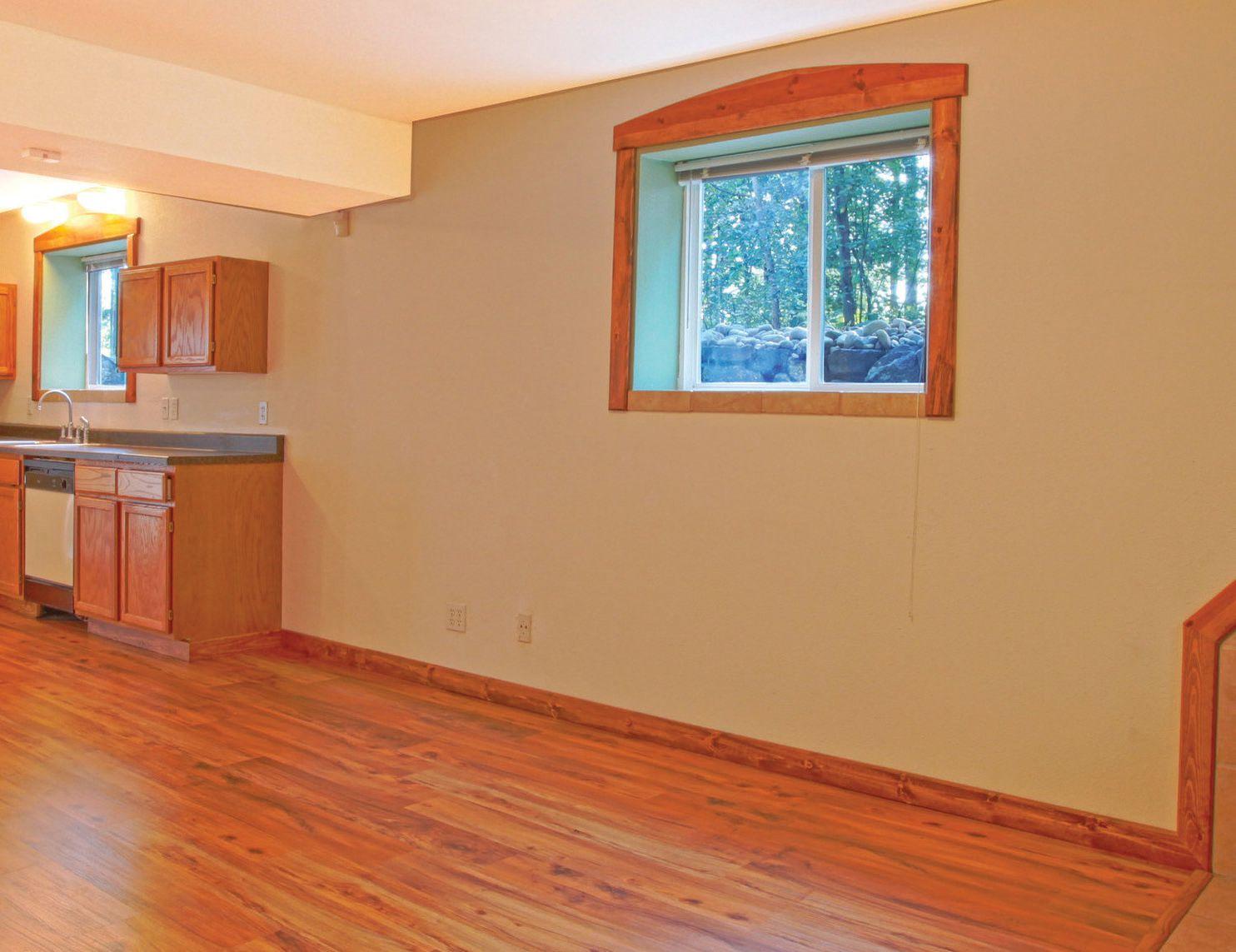
As a contractor, no doubt you’ve been asked to solve tricky problems over the years. Now and then you probably even get blamed for problems you didn’t even create. Summertime basement humidity and mustiness is a common case in point. Whenever outdoor temperatures rise higher than the temperature inside a basement, the problem of warm-weather condensation can occur. This triggers the kind of basement mustiness and mould growth that everyone hates. Problems like these can be your fault if
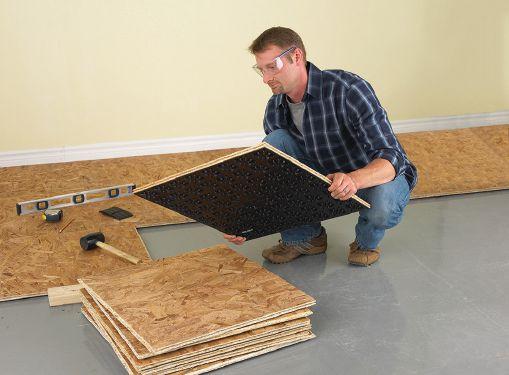
you finish a basement without understanding key moisture issues, especially as they relate to basement floors. And I’m not talking primarily about leaked water here, either. The real culprit behind mould-promoting basement moisture is water vapour and invisible condensation. This is where it’s important to understand what’s behind basement moisture dynamics and how to make sure you’re not responsible for finishing basements in a way that turns musty in a few years.
Strategy#1: Always install an impervious subfloor What would happen if you built a house, insulated the walls with fibre-type batts, but neglected to install a vapour barrier? Condensation would occur within the wall cavities during cold weather, that’s what. The same dynamic occurs with basement floors when they don’t include a vapourimpermeable subfloor on top of the concrete. If warm, summertime air is allowed to make its way through, say, carpet and underlay, eventually that warm, humid air will begin to cool as it makes its way through the carpet and close to the floor. And if this air gets cool enough, the air can easily drop to the dew point. The resulting water droplets forming within the carpet or underneath a hard-surface floor is the last thing you want happening on your watch. The solution? Install vapour-impermeable subfloor panels
Vapour-impermeable subfloor prevents carpet from getting wet and gaining that classic basement smell.
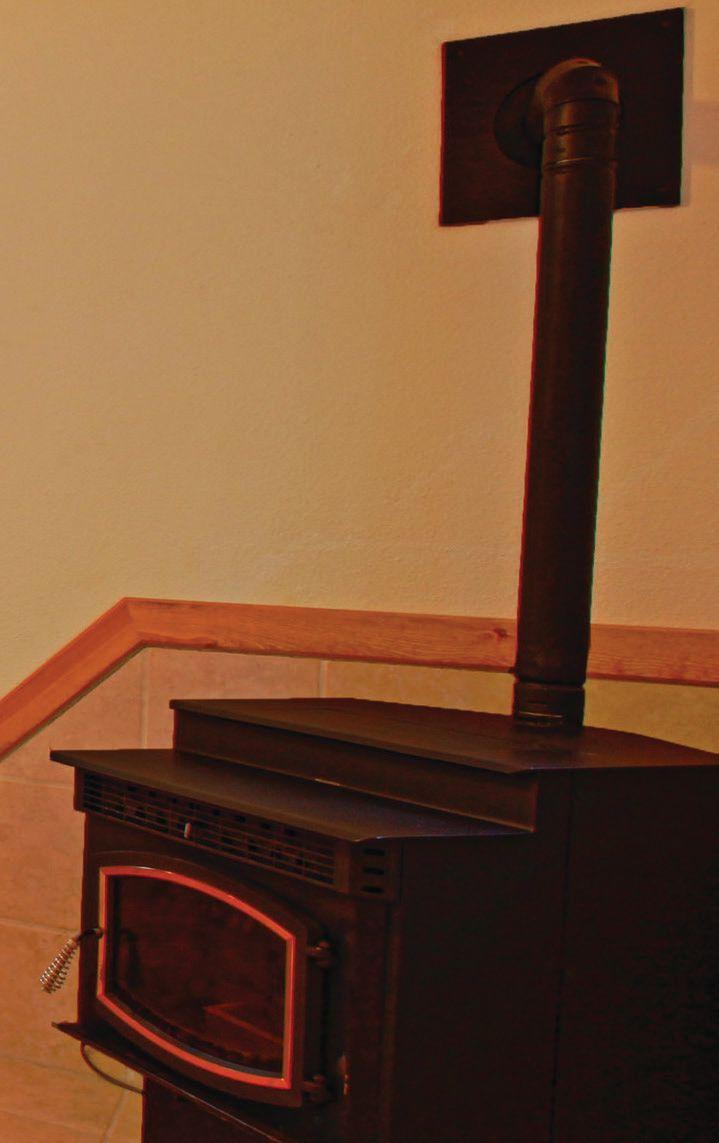
before any type of finished basement flooring goes down. The most widely available option is Canadian-made Dricore subfloor panels. Besides making feet feel warmer in winter, these panels prevent humid air from ever getting to the cool concrete condensation zone. The plastic layer on the bottom of the panels is key to the vapour-barrier action. These panels also make floors feel warmer in winter and more pleasant to walk on.
Strategy#2: Educate your clients about basement window management
Water vapour and condensation is the biggest hidden cause of mould, mildew and mustiness in finished basements. And we all know that ventilation is the cure for mould, right? Not always. Understand that whenever the temperature outside a house is higher than the temperature inside the basement, the possibility of condensation in the basement exists. And the greater this temperature difference from inside to outside, the greater the condensation potential. So, how does this shake down into actual homeowner management of the basement you’ve just finished? Here’s a simple rule of thumb that does not fail: never open basement windows when it’s warmer outside than it is in the basement. Why? Because the warm, moist outdoor air itself can be the source

ventilators can improve air quality and save energy. But choose wisely.
of moisture. Explain to your basement clients that they need to keep a humidity meter in the basement and take active steps to lower humidity if it gets any higher than 65 percent during the summer. How? There are only two reliable ways: a dehumidifier (decent but not great), or air conditioning (uses less power than a dehumidifier for a given amount of moisture elimination, plus it cools the space). Opening basement windows when it’s hot outside simply causes basement humidity to rise. Try it yourself and see. You can finish a basement properly, but if your client often opens windows when it’s hot and humid, chances are moisture problems will appear anyway. It won’t be your fault, so you need to explain things sooner rather than later.
You’ve probably noticed how often people are concerned about indoor air quality in their homes these days. The crazy thing is, most of the health-conscious clients who talk about this are barking up the wrong tree. They think they can enjoy excellent indoor air quality by avoiding materials that include chemical contaminants. A good start, yes, but never enough on its own. Even if you finished a basement using nothing more than organic tofu, without a molecule of urea formaldehyde anywhere, indoor air quality would still be less than ideal. People breathe, viruses build up, and there’s always off-gassing of something somewhere in the house. This is where one of two kinds of mechanical ventilators can help. You need to choose the right one for the situation and instruct your clients to use it properly.
A heat-recovery ventilator exchanges outdoor air for indoor air while retaining a large portion of the energy invested in heating or cooling that indoor air. HRVs are ideal for use during the heating season because they extract moisture from the outgoing air stream while also preventing that moisture from combining with the incoming air. An energy recovery ventilator reclaims the energy invested in conditioning that indoor air, but it also preserves whatever moisture profile exists indoors. This means ERVs are ideal for use during summer months because it keeps humidity outdoors better. HRVs, by contrast, are superior for wintertime use because you want moisture to leave the house, not stay inside it. cc
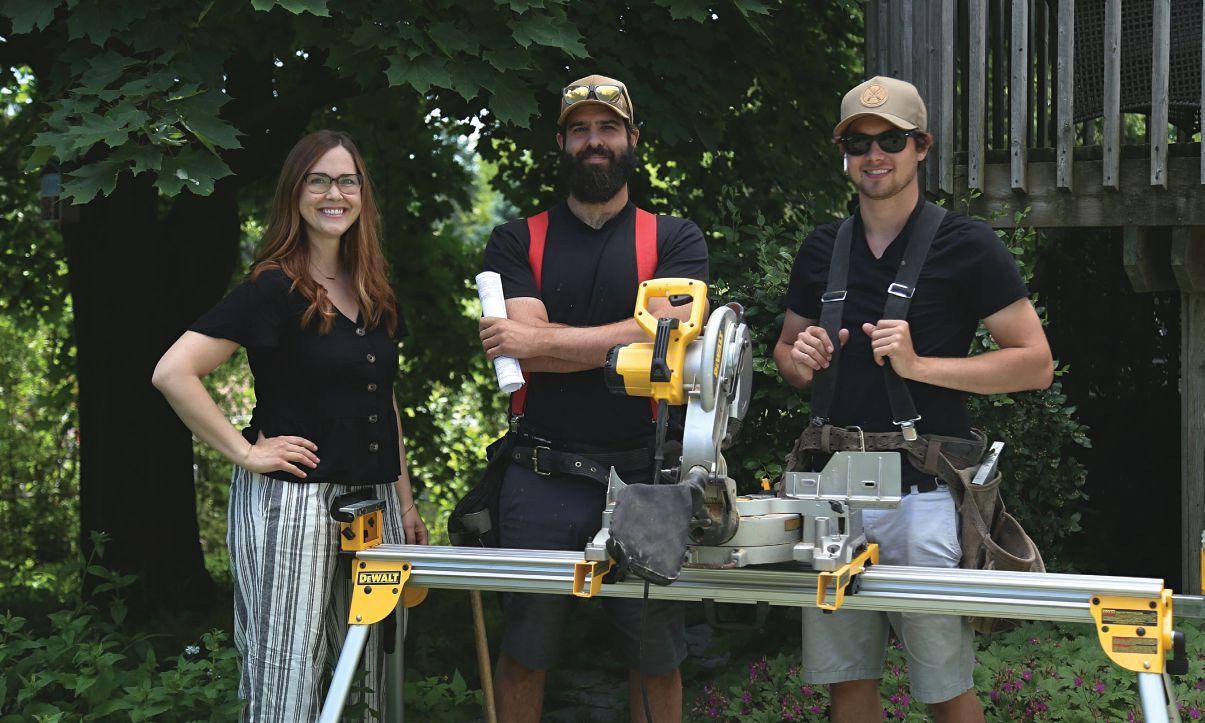
By Andrew Snook
Three might be a crowd to some, but for the owners of Otis Interiors, it’s the perfect number for creating the ultimate renovation experience.
The young company started up in Guelph, Ont., in March 2019, and was created through the collaborative efforts of the husband and wife team of Marc Esposito and Jasmine Koblik, and their friend and colleague, Joe Newcombe. All three owners possess complementary skill sets that allow them to create a one-stop shop for homeowners.
Esposito, 35, started his first career in public relations and worked in the corporate world until he was 25, when he decided to change directions and get into the trades. He always found the trades interesting growing up, watching his father do work around the
house – finishing basements, building decks – but never thought of it as a career choice.
“The word ‘trade’ was a dirty word growing up in high school,” he says. “Every decision in high school was university related. I always thought it was a pastime or a hobby.”
But after graduating university and working a few years, he found himself growing restless.
“I didn’t enjoy going to and sitting in an office every day,” he says.
A good friend of his parents owned his own renovation company. So, he went back to school and started an apprenticeship with a plumber and changed course.
For Jasmine Koblik, the renovation business was also a second career. Koblik started her first career in the corporate world in marketing and event management. At first, she enjoyed the creative aspects of her role. But after changing course and getting into the education sector, she found the
structure fairly rigid, and longed for a career that allowed her to be immersed in a creative role again. So, she went back to school four years ago and got into the design and decoration aspects of renovations.
“I knew I wanted a change and I wanted to get into something creative again,” she says.
While going through school, Koblik began taking on a few clients here and there.
“Towards the end of my program I got really serious about it and really wanted to make the transition into doing this further,” she says. “While I was going through all that, Marc, Joe and I had been talking that maybe we should do this together at some point and we should give it a good go, because there’s opportunity here. It just further evolved from there on.”
Joe Newcombe, 27, has been involved in renovations his entire career. He went to college for a two-year program in renovation
construction then jumped into the industry working for a renovation contractor that did work on an HGTV show.
“It was helpful to see that side of the industry,” he says.
Newcombe worked there until leaving to join Fusion Homes, a homebuilder in Guelph, which is where he met Esposito.
“Marc and I linked up and performed pretty well there,” he recalls.
Esposito eventually left that company to go to work for another builder in the Guelph area. One year later, the duo found themselves working together again.
“That place didn’t work out and we thought, why not try our own thing,” Newcombe says. “Let’s see what we can do to fill in the voids our [old] company had.”
Otis Interior’s focus is higher-end renovations, giving clients top notch service from the design phase to the selection of materials to the completion of construction.
“We’re really trying to make sure we use our strengths to our advantages, because we come from all different places with our backgrounds,” Koblik says.
Esposito feels one-stop shops for the higher-end renovation market is currently underserved and that his team are in a position to offer the kind of solid customer service that homeowners desire.
“We focus exclusively on residential renovations,” Esposito says. “We feel our value-add is that we have design and build in-house.”
By incorporating all aspects of renovations under one house, the team at Otis Interiors believes this will help better manage the expectations of homeowners. Too often, Esposito says, the necessary considerations aren’t given to a client’s budget when design is completed by one company and then a separate contractor is later brought in to do the work. This sometimes results in the renovation contractor having to be the bearer of the bad news that the allocated budget doesn’t cover the full cost of the renovations.
“The entire focus is predicated on
getting that design done,” Esposito says.
The design side of the business, overseen by Koblik, is treated as its own separate entity during the design and build process. In addition to her certificate in design, Koblik has her aging-in-place designation for older clients looking to modify their homes.
She says that by putting money into the designs up front with the renovation contracting firm, the company can really nail down what the client is looking for and create more accurate quotes for the construction phase.
“We’ve gotten a lot of good feedback on this,” Koblik says.
It also gives the company an opportunity to address any issues they think might come up during the construction phase.
“When Jasmine goes through her revisions with clients, she presents issues or potential issues. She endeavours to meet their needs realistically,” Esposito says, adding that it’s important to explain to homeowners that sometimes they need to invest in “ugly money” before investing in “pretty money.”
“We can put $40,000, $50,000 or $60,000 into your basement, but if you have leaky windows then you’re not addressing core fundamental issues,” he says. “I’d rather get into a renovation where we’re doing a complete overhaul and gut.”
Although the company is a one-stop shop for build and design, homeowners do have the option of paying for the design stage and taking their drawings elsewhere, even if that may not be the most efficient option.
“Ideally, our goal is to filter people seamlessly into the construction from the design with us. Then we’re not competing exclusively on price,” Esposito says. “With the level of quality on renovations we seek to do, we’ll never win a bid exclusively on price.”
Esposito says he’s gotten calls from realtors looking for them to do renovations on homes they’re selling, but he’s not interested in that kind of work.


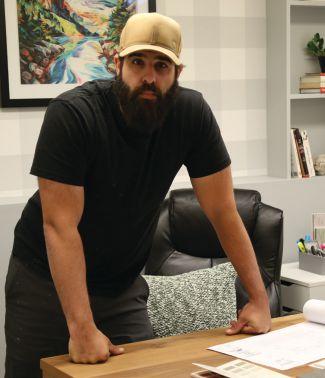
Otis Interiors has focussed on promoting the design aspects of the business during the pandemic.

“We get calls often from relators, but we’re not the right option for people selling their homes. We typically sell ourselves out of that market,” he says. “I’m not casting judgement. It’s just not our business model.”
With the pandemic arriving in Canada about a year after Otis Interiors started up, there have certainly been some unexpected challenges that the company has had to deal with.
“We lost our April and May work,” Esposito says. “We went barren from fully booked.”
To help counter the restrictions from entering clients’ homes, the company focused on promoting the design aspects of the business.
“We really pushed design services,” Esposito says. “We were pretty active on social media, letting people know we were somewhat operational on the design capacity.”
The company also took advantage of several government programs to help combat the loss in revenue and hired a marketing firm to set up digital properties for them, like a new website.
“We’ll see what the rest of the summer and the fall holds. We have more outdoor exterior work than we typically would. We got some cool gazebo and deck structures,” Esposito
says, adding that the company is also focusing on how to get into people’s homes with a safety protocol that makes all parties feel comfortable. “I don’t think we’re out of the woods yet.”
Adding to the challenge of operating in a pandemic is that assistance looking after young children is either limited or not an option at all for people right now in southern Ontario.
“The biggest challenge is the inevitable trying to juggle all the balls in one basket,” Koblik says, referring to the meshing of their personal and work lives.
The couple has a young son at home full-time with them. Koblik says the key to getting through the pandemic is to remember to be patient when feeling overwhelmed and appreciate the extra time with family.
“Having a husband-wife tandem with two-thirds of ownership has been quite beneficial,” Esposito says. “We’re able to chat about work when we’re feeding him or changing diapers… it’s worked out really well.”
One potential benefit from the pandemic is that some homeowners are more interested in doing work on their homes over the summer, since their ability to travel is limited.
“People still have renovations on the brain,” Koblik says, adding that some
of their existing clients are actually looking to do more than originally planned. “Because they’ve been in their houses with nowhere to go, they’ve actually banked a little bit more money to pump into these renovations. The ones who are still working have been saving more, so they can do a little bit more with what they have.”
As Otis Interiors grows, Esposito would like to see the company be looked upon as a high-end option for the KitchenerWaterloo-Cambridge market.
“We would like be seen as a premier option for mid- to high-end renovations within three to five years,” he says.
Newcombe would like to see them get more into a customer-driven niche market as they grow.
“We reflect on the customers we have, and the ones we get, and talk to them about what they think is really important,” he says. “Maybe it’s highend kitchens, or maybe it’s utilizing the basements for in-law suites… I kind of think the market will guide us along.”
Newcombe says it’s also important to keep a focus on what they enjoy doing the most.
“You do this to enjoy your day and your career choice, but that’s guided by the community with what they want provided for them.” cc

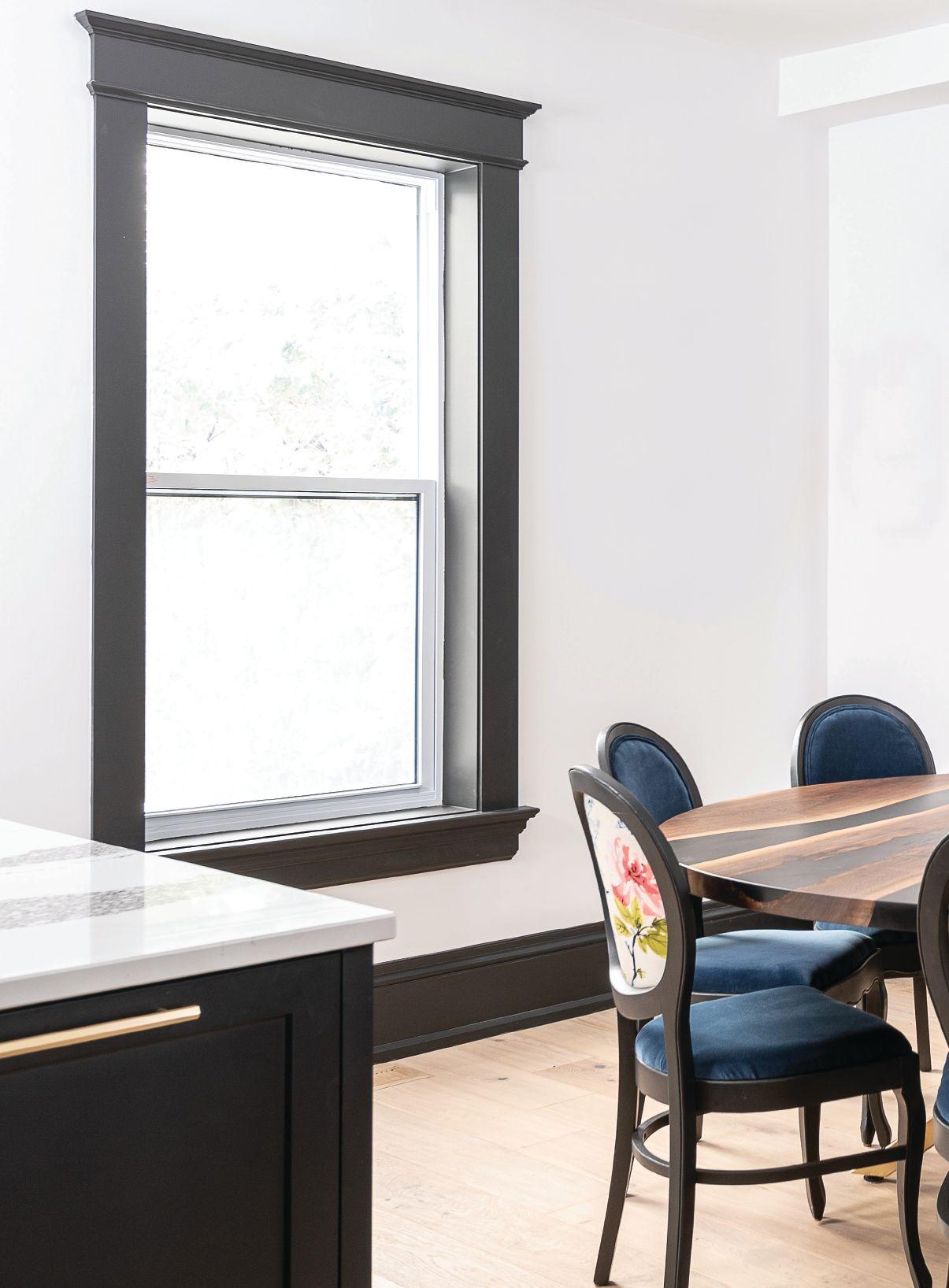
How Carmelin Design and Build created an award-winning project in Toronto’s coolest neighbourhood
By Steve Maxwell
Whenthe new owners of a century home in Toronto’s Junction Triangle neighbourhood bought their 2,200-square-foot brick place in 2019, they knew it was going to need a complete remodel and they wanted to start right away. That’s where the sister and brother team of Stephanie and Oliver Rota came in. Co-owners of Carmelin Design and Build, their team created an award-winning renovation that shows exceptional quality and attention to detail, and they did it by achieving six main goals.
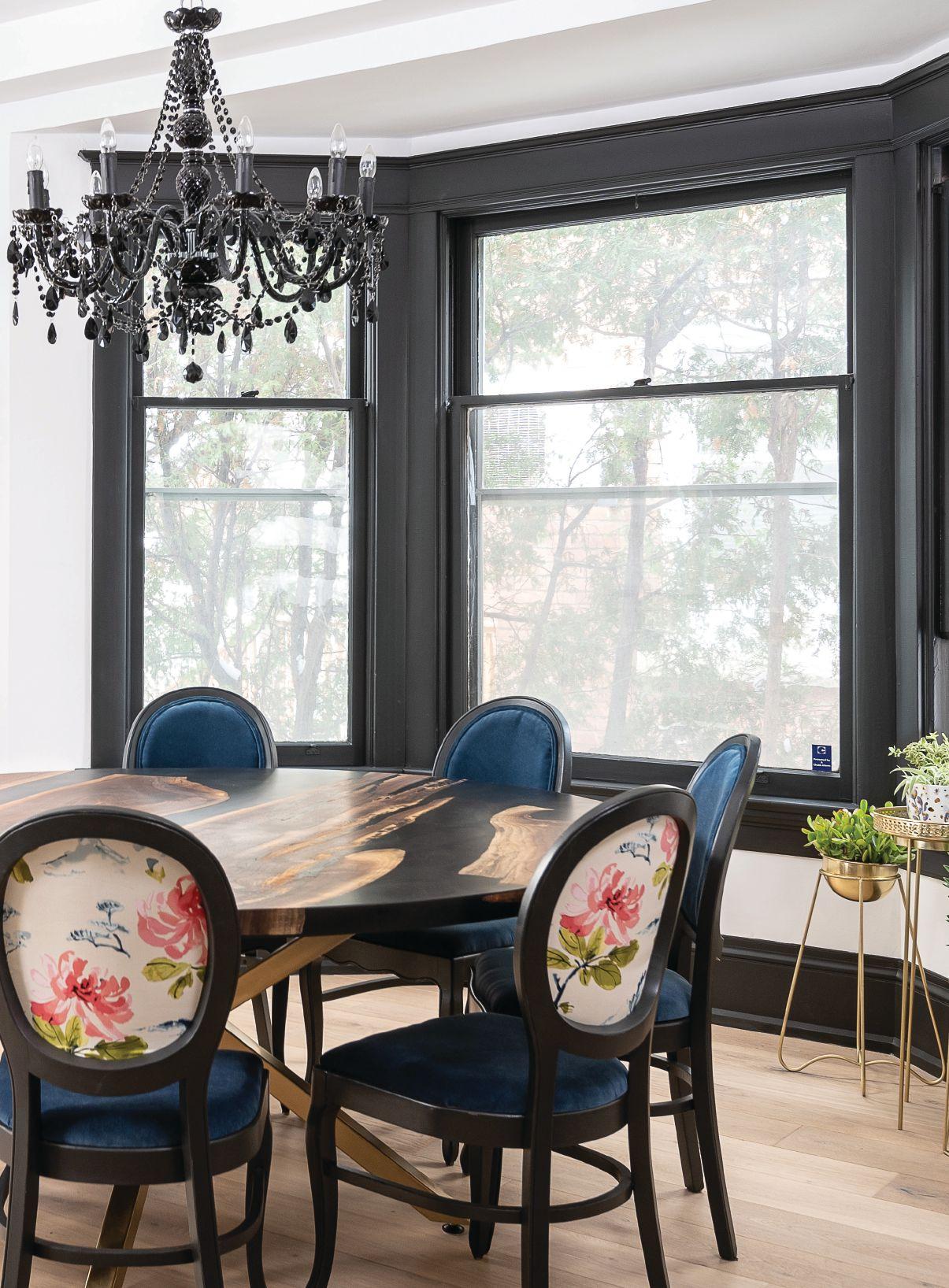
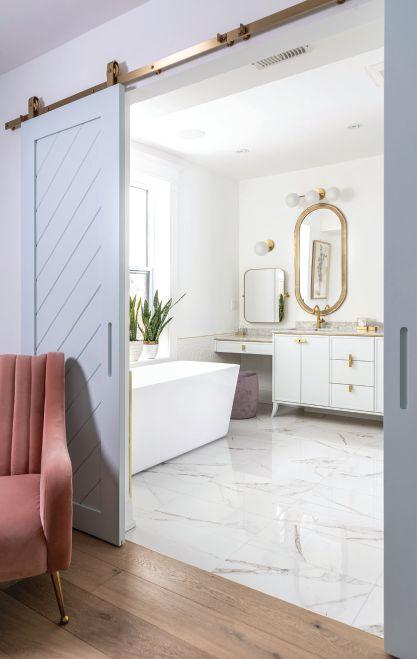
Goal#1: Boost functionality

“The clients for this project placed a high priority on functionality for their family home and making the most of the square footage for this project,” explains Stephanie. “They were happy to embrace design ideas, colours and materials outside of their comfort zone, resulting in a bold and beautiful home with as much character inside as the character of the Junction neighbourhood surrounding it.”
Work began by completely gutting the house from top to bottom, but with an added twist. “Our policy is to always get an environmental assessment of projects like this one,” explains Stephanie.” The purpose is to identify potentially hazardous building materials before demolition and construction disturb anything. Substances searched for include asbestos, lead, mercury, silica, arsenic, ethylene oxide and isocyanates, among others. As is typical with older homes there was some abatement required and it was easily dealt with safely.”
Carmelin was founded in 1984 by Stephanie and Oliver’s father, Mario Rota. “He settled in Canada with the first wave of Italian immigrants in the 1950s,” explains Stephanie. “He came from a long line of entrepreneurs and saw an opportunity in construction as a means to provide for his family. He was a charismatic, dynamic and honest man who put his heart into every project. Sadly, our dad passed away from cancer a few years ago, but we’re proudly continuing what he began.”
Carmelin is primarily a custom home builder, with 30 percent of their work going into renovations each year.
“We consider ourselves a boutique builder and typically complete six to seven projects annually,” explains Stephanie.
Oliver and Stephanie take a hands-on approach to each project. “Our team also includes highly talented
tradespeople, some of whom have been with us for over 20 years,” says Stephanie. “We also match the right trades and suppliers to each specific project in terms of scale and scope. This ensures that the same quality and reliability are brought to each home we build.”
Goal#2: Get the design work right
“We always spend time getting to know our clients. Who’s in their family? How do they live? What do they want out of their home? What are the important features and less important ones?” explains Stephanie. “Sometimes clients have spent years planning out their project and know exactly what they want. Others have a concept, but want help from us, leveraging our experience to offer suggestions on what is possible for their space. We start by getting a set of design drawings with the layout of the existing home and then secondary drawings that show alternate layouts. There are many different scenarios but we narrow things down as we learn client preferences. The most difficult part of the design process comes when a trade-off is necessary between a wish list and the physical constraints of the project or the budget. We always work to find a solution that clients are happy with.”
Goal#3: Open up the floor plan
As is common with older homes, the original floor plan of the Junction home included a lot of rooms and interior doors. Closed concept was common back then. “On projects like this, we work with a structural engineer to create an open floor plan using a combination of LVLs, steel beams and posts,” says Stephanie. “We aim to have posts hidden in existing walls to create the best look, avoiding awkwardly placed posts in the house. Open concept needs to be truly open.”
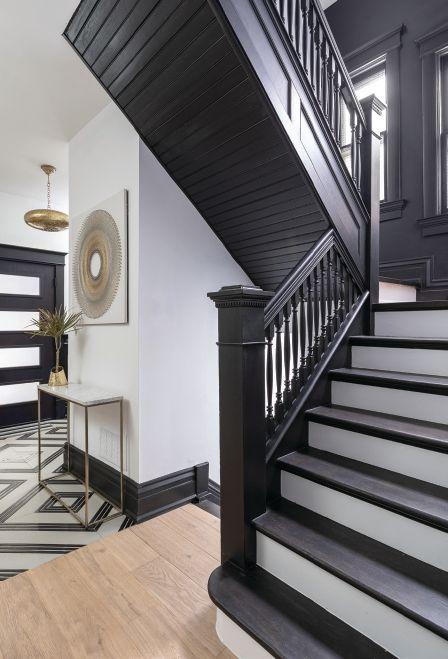
This past April, Carmelin won three BILD Awards, two of which are for the Junction home project: Best Overall Renovation and Best Renovation. So how do builders do well in competitions like these?
“Take lots of before-and-after photos and importantly from the same angles so you can really see the impact,” says Stephanie. “Be courageous with the finishes too.
Convince the client to step outside their comfort zone; the results are surprising.
It’s easy to match white and white. Go beyond that.
“The nature of home building is that new projects tend to generate referrals, and these referrals tend to cluster in a given neighbourhood. Currently, the majority of our work is in central Etobicoke. However, we also have a project in Danforth and have done work on a custom farmhouse north of the city. We’re happy to work anywhere in the Greater Toronto Area.”
Goal#4: Create exceptional interior details
One of the striking things about this project is the interior millwork. No cookie-cutter stuff here. “Trim and moulding were supplied by Rex Lumber, and for this project, we worked directly with the owner of the company,” says Stephanie. “Wherever practical we aimed to preserve the old gumwood trim, but since this wasn’t always possible we did have new trim custom milled to match the old.” Pieces of existing trim were removed and taken to a shop for custom grinding of cutter knives and milling. “Many suppliers on this project are local family-run businesses and they bring a level of care and attention that our clients appreciate. “It’s not just about finding the lowest-cost provider,” says Stephanie. “Quality matters more.”
Walking through the house, the fit, finish and design of the trim will catch your eye. All finish work on this project was done by a very talented carpenter, Jose, who has been with Carmelin for more than 15 years. He took a lot of time and care blending the new trim into the old. Projects like this are a lot different than new construction.
Goal#5: Finish the attic and basement
“It was important to the client to utilize every square foot of the house, and this meant finishing both the basement and attic,” relates Stephanie. The original attic was one big uninsulated storage space – just the way builders of
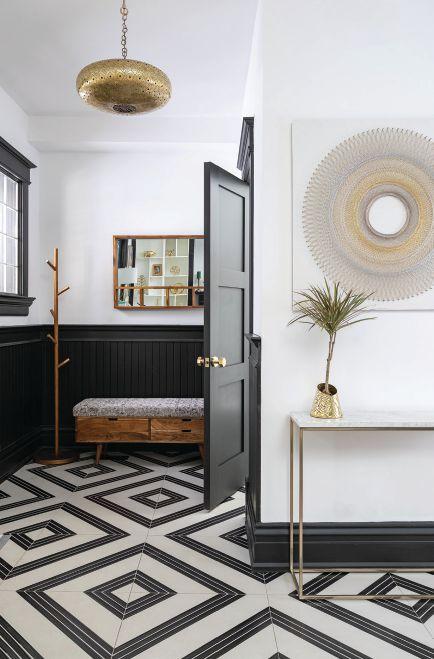
yesteryear often left completed home projects. Back then attics were the go-to space for stair-access of interior storage of seasonal clothes and other items because attics are drier and warmer than the old-style unfinished basements. “We redesigned the attic floor plan to accommodate two bedrooms with a shared bathroom in the middle. We also added skylights in the stairwell and a bathroom to bring in as much natural light as possible. The result was an entire new third floor of living space, fully insulated, giving two boys their privacy.”
The basement was completely finished along with the rest of the house. There’s now an outside entrance to the basement and a big mudroom, bathroom and rec room for the kids,” explains Stephanie. “Our assessment of the basement was that the block foundation walls were in very good shape and it was a dry basement. All in all, perfect for finishing.”
Goal#6: HVAC upgrade
“We made a decision in consultation with the client to eliminate the old HVAC system and replace it with new,” says Stephanie. “The layout of the house changed considerably from the original, and with two bedrooms on the third floor, an open concept on the main floor and a reconfiguration of the second-floor layout plus a finished basement. The old system of duct work was no longer going to properly serve the new home. The new forced-air HVAC system was designed by a consultant to handle the whole house.
Renovating an older home is about more than just making things new. The best projects also retain something of the history and character of yesteryear. While Carmelin’s Junction project has created a home that’s more comfortable and more usable than the original ever was, it’s still got something of that cool, old house feeling that people love so much. cc

Portable battery-powered electrostatic sprayer
Keeping work spaces, public spaces and other areas with heavy foot traffic clean is a necessity, especially in the current times. Larson Electronics has therefore introduced a product that is designed to disinfect large and hardto-reach spaces and surfaces – the IND-MD-DF-ESF-R1
Portable Battery-powered Electrostatic Sprayer.
The electrostatic sprayer is a wireless device that sprays a disinfectant mist onto surfaces, coating them with a layer of the sanitizing agent added by the user. The sprayer comes with a 4.22-gallon tank, lithium-ion battery, power charger and nozzle adjuster.
This sanitation product can be used to disinfect a variety of areas and spaces, including gyms, offices, daycare centres, warehouses, airports, healthcare facilities, outdoor areas (playgrounds, concert venues, amusement parks, campgrounds), work sites, factories, farms and laboratories.
It is often difficult to access small cracks and crevices on some surfaces and objects. In such cases, a liquid cleanser
Trex RainEscape’s latest product – Soffit Light – is designed to help contractors and homeowners optimize and highlight the space beneath an elevated deck. The new product is a directional LED downlight that installs into the ceiling below a deck drainage system on an elevated deck.
The Trex RainEscape Soffit Light is compatible with the Trex outdoor lighting collection and the Trex LightHub system. It may be used with decks that are outfitted with the Trex RainEscape deck drainage system to complete the look of an under-deck ceiling and living space. The fixture is easy to install and has been designed as an energyefficient option.
“With the Soffit Light, any builder or DIYer can easily upgrade the underside of a deck with professional outdoor lighting without having to hire an electrician,” said Dave Kile, North American sales manager for Trex RainEscape. “The plug-and-play components integrate seamlessly with Trex Outdoor Lighting components. They may also be installed individually to help make an outdoor living space safer and more usable, year-round.”
The Trex RainEscape Soffit Light is available in bronze, black and white finishes. It features CREE long-life LEDs that consume less energy compared to standard can lights.
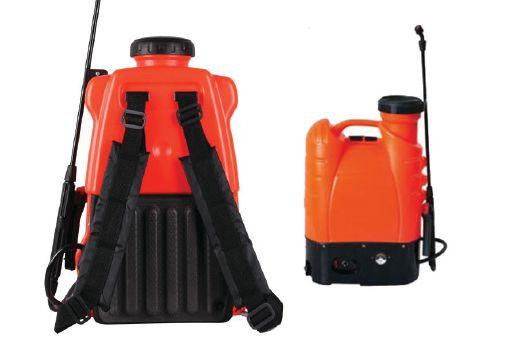
sprayed as a mist is able to reach these areas much easily. The flow rate of the electrostatic sprayer is 100 cubic metres per minute, allowing cleansing agent to cover large areas and objects in a short amount of time, quickly and easily. This sprayer can alternatively be used to perform pest control or spray plant fertilizer.

The light has been engineered specifically for outdoor use. It features durable and weatherproof (resistant to water and salt air) components. The product is built to withstand extreme elements and harsh climatic conditions for years. For additional assurance, Trex RainEscape offers a limited five-year warranty on the LED light and a 10-year warranty on the powder coating.
Designed with easy-to-install technology, each Soffit Light comes with two steel spring tension clips that hold the fixture securely in place on any type of soffit material. The individual units can be connected to each other and to other deck and landscape lights using the Trex LightHub system with no additional wiring or wire splitting required. An optional timer and remote-control dimmer are also available for total lighting control.
DAP has added a line of acrylic urethane sealants called Power Point 300 to its line of Power Point caulks and sealants. The Power Point product line is specifically formulated for professional painting contractors.
Power Point 300 is designed to provide ample flexibility and strong multi-material adhesion for a durable seal that won’t crack. DAP is offering the sealant in a full line of 14 colours to match today’s top trim and siding colours.
“Not all sealants have the performance features needed to stand up to demanding joint movement seen in both interior and exterior applications, which can cause them to crack and break down,” said Justin Lingenfelser, product manager at DAP. “New DAP Power Point 300 has a unique urethanized formula for strong multi-surface adhesion and up to 600 percent stretch, allowing it to seal gaps up to three inches wide without cracking. It’s designed to stand up to the constant expansion and contraction that homes go through as the seasons change.”
Power Point 300 may be used for all types of interior or exterior projects. It is a waterproof and weatherproof seal. It has a two-hour paint ready time, is easy and smooth to apply, has low odour and water clean-up. The product is compatible with most paints and won’t shine through, dull or discolour paint or cause paint film cracking.
DAP is offering a lifetime guarantee on the product for added assurance about the sealant’s durability.
Power Point 300 is available in a range of colours,
Strong-Tie Outdoor Accents Avant Collection
Simpson Strong-Tie has recently added the Avant Collection to its Outdoor Accents line of decorative hardware. The new collection is designed to add “beauty and strength” to outdoor projects.

including white, clear, off white, almond, tan, limestone, woodtone, bronze, aluminum gray, stone, redwood, redwood tan, pine green and black.
“The full colour line was designed to match top trim and siding colors, allowing painters to create a professional finish without the need to paint over it,” added Lingenfelser. “This saves time and allows for a professional finish, quickly.”
Power Point 300 joins the line of other DAP Power Point Caulks and Sealants that has been specifically formulated for professional painting contractors: Power Point 230 Elastomeric Acrylic Latex Sealant, Power Point 210 Fast Dry Siliconized Acrylic Latex Caulk, Power Point 200 Allpurpose Siliconized Acrylic Latex Caulk and Power Point 100 Acrylic Latex Painter’s Caulk.
DAP Power Point 300 is available for purchase in paint stores from July 2020.
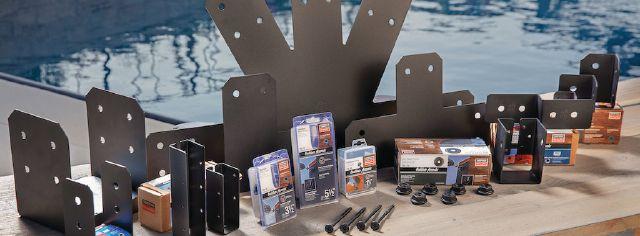
To achieve a clean, polished look that goes with different types of design, the Avant Collection features straight edges, chamfered corners and black powder-coat finish. DIYer and brand ambassador Jen Woodhouse used the Avant Collection of structural connectors to build an outdoor pavilion in two days.
The word ‘Avant’ stands for advanced, avant-garde, leading and forward-looking. Simpson Strong-Tie selected this word as the name to represent the “clean, modern lines
of this new collection”.
The Avant line can be used both indoors and outdoors. However, it has been designed and manufactured specifically for exterior applications. It features ZMAX galvanization for corrosion protection and black powder coating for aesthetics.
The Avant Collection wood connectors, as well as its washer-screw combination – are all load rated.
Bryan had a decking job in London, Ont. He was replacing the boards on an existing deck around a pool without removing the structure, so there was no flexibility on what size boards he could use. He ordered two-by-six boards from one of the big boxes and they were delivered to his customer’s driveway the day before the job was to start. Arriving the next morning to start the job, he found the store had delivered two-by-fours. He called the store and they quickly brought a load of two-by-sixes. This time, Bryan was standing in the driveway to see the load dropped off and ensure it was right.
After dropping the load off, the driver started to get back into his truck. “Wait a second,” Bryan said. “What about the two-by-fours?”
The original wrong load of boards was still sitting in the customer’s driveway where it had been left the night before.
“I only have paperwork to drop off a load, not to take anything back,” the driver replied. “Maybe the store is going to send someone else out for those.”
The driver left, leaving about $2,000 worth of deck boards where they were, and leaving Bryan musing about the wonders of corporate bureaucracy.
Bryan got to work on the customer’s deck fully expecting to hear from the store any minute. But three days later the job was done and no one had attempted to contact him about the extra load of boards. There they sat, orphaned by a clerical error. The customer was away on vacation while Bryan was doing the job, and so had no knowledge of the snafu.

Last issue, we asked how Lyle should deal with employees who couldn’t or wouldn’t work during the pandemic. Does he keep the replacement workers he hired, some of whom were excellent? Or does he show loyalty to his experienced staff that know his business inside and out?
David Katz of Total Reno and Design in Toronto picks up the win by suggesting a combination of both. We liked David’s reply because it focused on the longterm need of the company for the very best talent available.
1. I would do an analysis of what talent is available in the labour pool to hire back and rate them according to experience. Try to hire the best of the best.
2. Good employees are impossible to find today, so I would select the best of the staff who left and hire them back. They are trained and know the business. That is worth the time and money saved by hiring new.
3. Anyone who was questionable, even though they have tenure, I would take the opportunity to replace. As an employer you do not get that opportunity EVER without costing money.
4. There must be some weight given to those who stepped up during COVID-19 and I would keep the best of the best from that pool of workers. They stepped up during a crisis and that shows loyalty. A rare quality in staff today.
5. Good tradespeople are impossible to find today. He should select those who will benefit his business plan for the future. Do not just concentrate on the three big projects coming up. That would be short-sightedness and not a smart business move. Plan for the future.

1. Reach out to the store, tell them about the mistake and see if they’d come get the boards. After all, he doesn’t want to get into trouble if the error is found later, and he needs a good relationship with his supplier.
2. Quietly load the boards into his truck and depart, thinking about the nice margins he’ll get on his next deck job if he can talk the customer into using that style and size of wood.
3. Tell the customer he’s giving them a parting gift of materials for a second deck. After all, the customer paid for the deck boards so technically the extra load belongs to them.
4. Get on Kijiji and sell the load for $1,500. The buyer picks it up, the problem goes away and Bryan has some walking around money.
5. Something else?
If you have a solution for Bryan’s ethical dilemma, email your entry to pflannery@annexbusinessmedia.com and put “Bryan dilemma” in the subject line. Please don’t post your response as a comment to the Dilemma post on our website.
Entries close August 17. The winner will be announced in the next issue.





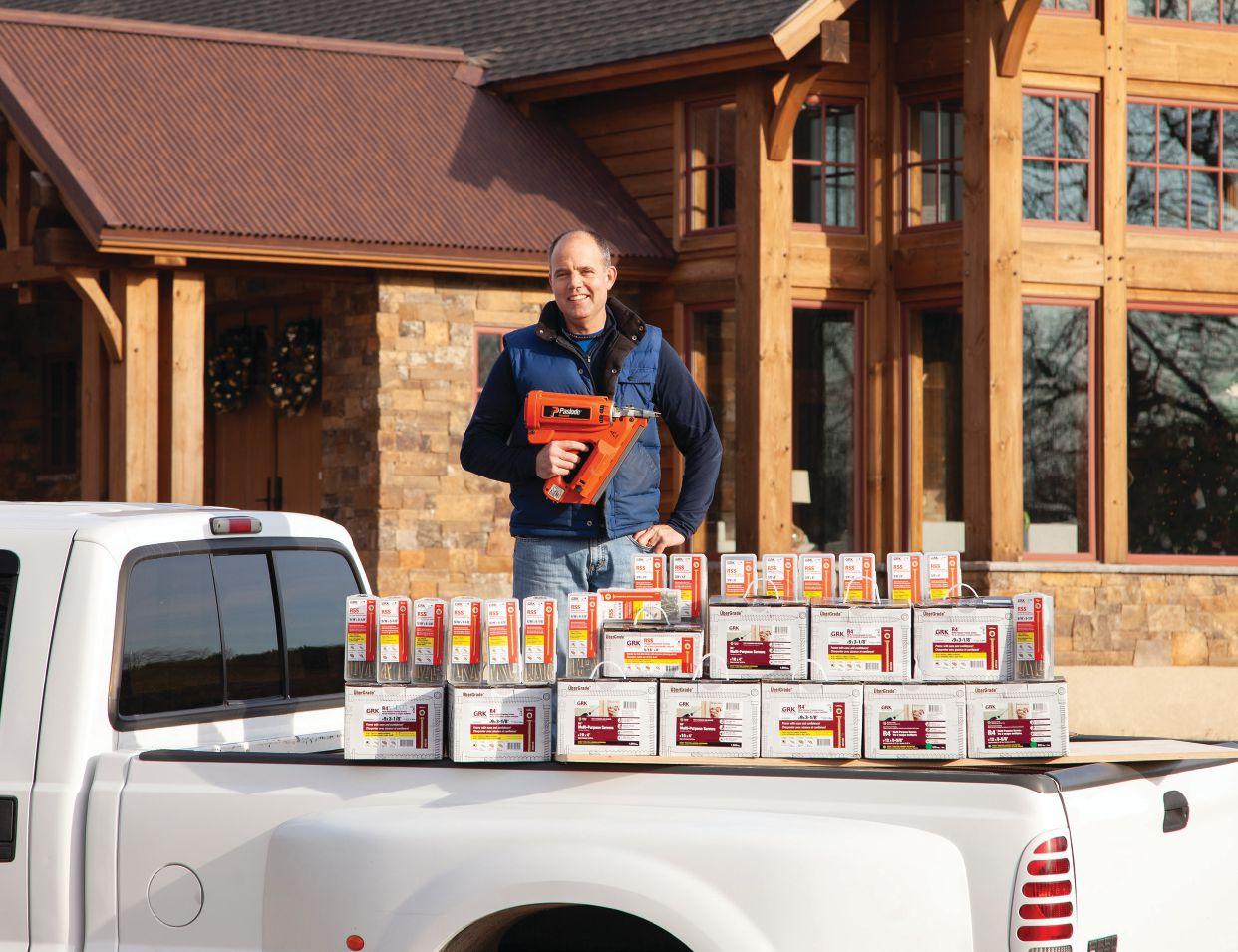
HE WON $5,000 WORTH OF GRK FASTENERS!
Last November, contractor Ben Crocker of D.F. Crocker Ltd., St. Thomas, Ont., won $5,000 of GRK Fasteners and a Paslode Impulse Framing Nailer. Ben won because he sent us the above photos of a splendid project he built, The Willemse House, which made extensive use of GRK Fasteners.
That’s how easy it is to enter the 2020 GRK Projects Contest. If you’ve built something with GRK products in it – no matter what type of construction it is – let us have a look. When we pick the winner, it could be you. And that means not only these great prizes but a feature story in Canadian Contractor magazine in our Jan/Feb 2021 issue.
Go to CanadianContractor ca. In the search bar, look for 2020 GRK Project Contest and click on the link. You will see that you can submit up to 3 photos and a description of the project, and how you used GRK Fasteners to built it.
GOOD LUCK! Entries close November 30th, 2020
